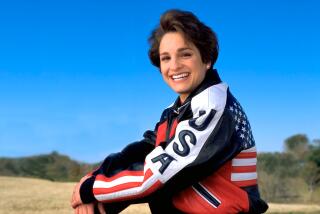Big Things Are Expected From Little Gymnast Kristie Phillips
- Share via
HOUSTON — By day, Kristie Phillips is a freshman honor student. At sunrise, sunset and on weekends, the 14-year-old tumbles and trains to become America’s next Olympic gymnastics gold medalist.
“I just enjoy it,” Phillips says of her tortuous schedule of up to 40 hours a week at the gym.
Life is routine: At the gym by 7 a.m. for two hours of tumbling, dance and vaulting, then off to school. By 5 p.m., back at the gym for four more hours of the same.
“I want to be the best in the United States and if I want to be the best, I have to train under the best coach,” she says.
That meant leaving Baton Rouge, La., and moving to Houston two years ago with her mother to train at the gym run by Bela Karolyi, the Romanian expatriate who introduced the world to Nadia Comaneci in 1980 and Mary Lou Retton in ’84.
It was not the first move for Terri Phillips and her daughter, who made earlier training pilgrimages to Shreveport, La., and Atlanta. It can get expensive, too.
“We just do without a lot of things,” Terri says. “It’s tough sometimes, but we just have to sacrifice.”
Kristie’s father, Jim Phillips, continues to work for Exxon Co. in Baton Rouge, and two of her three older brothers still live there.
But her training with Karolyi already has paid off. She won a triple crown in 1986, winning the American Cup, the junior title at the Championships of the USA and, despite a broken wrist, four gold medals at the U.S. Olympic Festival in Houston.
The 4-foot-9, 78-pound gymnast’s scores at the championship competition were enough to capture the senior title, but her age prevented it--the senior level starts at 15.
“We’ve been waiting 11 years for her to turn 15,” Kristie’s mother says. In March, she finally does.
“At age 4, she had a lot of natural liking and natural ability for gymnastics,” Terri says. “Now I feel she’s committed. But I’ve told her she can quit any time she wants to.”
Phillips’ greatest gymnastic strengths, according to her coach, are the balance beam and floor exercises.
“She’s an excellent, flexible kid. She can produce a lot of surprising-looking things,” Karolyi says, referring to a balance beam maneuver now called the Phillips, in her honor.
Phillips begins the startling contortion in a handstand, then curls her back until her legs are parallel to the ground. At this point, her rump is just above her head so she can stare at her heels. After holding the position, she does a split with her back still bent.
“With Mary Lou, she had natural strength, spirit, outgoing personality,” Karolyi says. “Kristie is a different personality and different body type. Her strengths are coordination and flexibility.”
“We’re two different people,” Phillips says of Retton.
Right now, training is focused on the 1988 Olympics in Seoul, South Korea. Competition, Phillips believes, will come from her best friend, Phoebe Mills, the East Germans, Romanians and Soviets, whom she beat to win the American Cup.
Her schedule alone indicates training with Karolyi is anything but easy. Interviews, for example, are allowed only for only a few minutes one day, a few more minutes the next.
“I’m used to it,” Phillips says.
Karolyi says that of the 900 gymnasts who train at his Karolyi Gymnastics, Phillips may not even be the best.
‘It’s hard to say because they are so close,” he said referring to Phillips, Mills and Julissa Gomez. “You have to wait until the competition to see who finishes first.”
Karolyi says he wouldn’t be surprised if his students make up the U.S. Olympic team--composed of the top five finishers at the Olympic trials--because they win most of the titles in U.S. and international meets.
“We had a great showing in the American Cup and she won,” Karolyi says. “It was pretty conclusive we can compete, but we still have a year and a half and anything can happen both good and bad.”
Like Retton, Phillips says she will retire after the Olympics.
“After 1988, I don’t want to train anymore,” she says. “By that time, I will have already accomplished what I wanted, so I’ll just let others accomplish what they want.”
More to Read
Go beyond the scoreboard
Get the latest on L.A.'s teams in the daily Sports Report newsletter.
You may occasionally receive promotional content from the Los Angeles Times.






